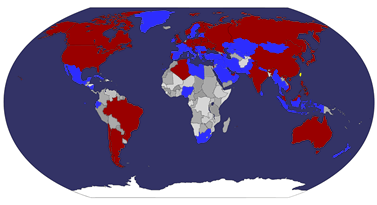Date of issue: October 16, 2014
Established in 1914 in Yuanshan, Taipei Zoo is the oldest zoo in Taiwan. It relocated to Muzha in Wenshan area 72 years later. The year 2014 marks the zoo’s 100th anniversary. To commemorate this ocassion, Chunghwa Post is releasing a set of six stamps featuring protected wild animals. The designs follow:
1. Formosan Serow (5TWD): This serow is dark tan in color all over. The center of its nape is black. The underside of the chin, the jaw, and the throat are light tan. It has a short tail. Both the female and the male wear conical horns that stay with them lifelong.
2. Formosan Pangolin (5TWD): It earns its Chinese name for its armor shells and its preference to dig burrows. It has a conical head, a pointy mouth, small eyes, and thick eyelids. With the exception of its mouth, the cheeks, the chin, the throat, the belly, and the inside of its four legs, the animal is covered in taupe-colored shells. Though toothless, it has five claws on all of its four legs; its forelimbs are particularly strong.
3. Asian Elephant (10TWD): The Asian elephant is a majestic animal with four powerful legs, and dark gray coloring. Its tube-like, boneless trunk is an elongation of the upper lip and nose combined.
The trunk is built with flexible muscle tissues, and can be manipulated, extended and contracted at will. The elephant uses its trunk for drinking, grasping objects, picking up food, and watering with ease.
4. Formosan Black Bear (10TWD): The bear has black, coarse fur all over, with a tuft of white hair on its chin. On its chest is a distinctive, whitish "V" pattern. The bear is a subspecies endemic to Taiwan, and the largest land mammal on the island.
5. Bengal Tiger (12TWD): It has yellow or muster yellow coloring, and is covered with thin, black stripes; the stripes on its head are more densely distributed. Its belly is white. The back of its ears is black, spotted with white. The tiger has an excellent sense of hearing, razor-sharp teeth, and retractable shark claws. It is an apex predator in the forest, with stripes that offer exceptional disguise.
6. Giant Panda (12TWD): It has a pair of black eye patches, four strong limbs, and a thick black-and-white coat for protection in snowy winters. Its plump body allows him to survive on a bamboo diet, and a cool, damp weather. Its small black ears help him conserve energy. The design of this stamp features 4-month-old Yuan Zai snuggling to her mother Yuan Yuan.
"Arab League Summit 2003" stamps on cover from Bahrain
-
*Timbres "Sommet de la Ligue Arabe 2003" sur lettre du Bahreïn *
Un grand merci Mohamed pour l'envoi de cette jolie lettre, envoyée le 12
décembre 2023 d...
12 hours ago














.png)




















 taiwan
taiwan  cover or postcard
cover or postcard  FDC
FDC 





























































































